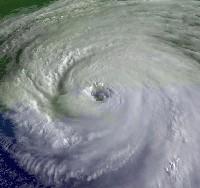Organizational dysfunction at the Corps of Engineers
I couldn't find the audio in the WWL archive, so I'll have to summarize one of the best interviews I've heard post-Katrina: WWL's Tommy Tucker talking to civil engineer Bob Bea about why the levees failed.
I caught the interview while channel surfing this morning. It actually aired between 7 and 7:30 a.m on the 101.9 "Perspectives" program.
We all know about the countless engineering flaws that led to levee system failures around New Orleans. What hasn't been explored at length is the role of bureaucratic dysfunction at the Corps of Engineers in created those failures.
I've written in other posts (here and here, for example) about my confidence in the scientific and engineering capabilities of friends I know who work at the Corps of Engineers. Many of them lost their homes too, and are feeling that the vitriol aimed at the Corps of Engineers is directed at them personally. On top of their own personal tragedies, they're feeling that they haven't been given a right to grieve for themselves. In fact, they've been working constantly around the clock since Hurricane Katrina, and haven't had an opportunity in many cases to deal with their own personal situations.
As I've said before, it's not enough to target the engineering failures of the Corps of Engineers, but to truly prevent future engineering problems, we have to first understand and address the political pressures that led to institutional failures. The science about how to build levees right has always been there. The Corps of Engineers knows how to do it, so why did the levees fail?
The answer, elaborated by Bob Bea in the Tommy Tucker interview, can be found principally in post-Betsy politics. As it began levee improvements after Hurricane Betsy hit New Orleans in 1965, the Corps was frequently criticized for cost overruns and delays. The Corps has always been a victim of politics, but in this case, the role of politics was deadly.
The Corps began modernizing its project management and accounting systems, subjecting projects to cost-benefit analyses that compromised engineering best practices. At the same time, however, Congress began using appropriations as a weapon against the Corps (unless a member of Congress wanted a pork-barrel project in his or her district). The Corps was forced to make do with whatever appropriation it was given. Therefore, when, for example, the Corps was designing the specifications for how deep to drive sheet pile into the peanut butter and jelly sandwich composition of soils along the 17th Street Canal, an institutional decision may have been made to ignore previous studies done by the Corps in the Atchafalaya Basin in the 1960's which showed how to do it right.
What did Bea mean by peanut butter and jelly sandwich soils?
As New Orleans drained swamps by digging canals in the 19th century, and later began reclaiming land (as in Lakeview) by dumping fill on top of what was previously swampland, a layering of soil firmness was created. Firmer clays could be found down deep, below a stratum of loose swamp material, on top of which was layered more firm soils. When sheet piles were driven into that soil, they were only driven down to the level of swamp material, not down to the deeper clay. As a result, when Lake Pontchartrain began pushing against the canal walls during Hurricane Katrina, the walls and the soils they were embedded in, literally slid across the deeper clays as you could do with a peanut butter and jelly sandwich if you slid the two pieces of bread across one another.
It would have been better to build bigger and higher levees along the 17th Street Canal, but after Hurricane Betsy, homes were already built close to the canal, so the decision to use levee walls was made. That levee walls were constructed instead of dirt levees wasn't the problem. The Corps of Engineers can, and does, improve its engineering skill all the time. It knew how to build the levee walls, but then failed to do it right because of institutional failure created by political pressure.
The big question is when and why that institutional failure produced faulty engineering. As Tommy Tucker put it, scientists should have been pulling the wagon, not politics.
Should individual Corps engineers have spoken up if they knew the designs were flawed? That assumes that someone knew what was happening in a multi-tiered decision-making organization. It also assumes that the Corps had a system in place for self-criticism.
Bea argued that the Corps had, and still has, an organization that kills the messenger who bears bad news. I know that to be true. That's why, notwithstanding the fact that individual engineers know why the levees failed, the Corps as an organization keeps trying to publicly defend its actions.
In part, that might be due to the patriarchal military hierarchy of the Corps. It is also, however, a function of how the political goals of whoever sits in Congress and the White House percolate through the organization.
I've said before, and Bea said it as well, scientists at the Corps of Engineers need to be isolated from politics and bureaucratic dysfunction. There also needs to be an independent review process outside of the government -- something like the NSF-funded organization within which Bob Bea has been operating since Katrina.
We do need to know what the specific engineering faults were, but they may occur again if the institutional problems at the Corps of Engineers aren't addressed.
Tags: Hurricane Katrina | Katrina | New Orleans | Louisiana | We Are Not OK | Corps of Engineers | Levees | Levee Failure







3 Comments:
I've read everything I could get my hands on trying to understand this particular levee failure, but Bea's pb&j analogy was the perfect visual for me.
You're right that being "an organziation that kills the messenger who brings bad news," which flows directly from its being a "patriarchal military heirarchy" appears to be a central, cultural problem, which, left unremedied, likely infects any and all Corps projects, past and future, in NOLA and the rest of the country.
I am coming to believe that organizational structures in which information and authority flow from the top, down are dysfunctional by nature or design (the Catholic Church comes to mind).
You've done a great job of identifying the problem, but I don't see a simple solution, as it relates to the Corps' cultural issues and NOLA's flood protection.
I think you are pointed in the right direction. What occured where engineering failures in a highly technical sense that the politicl and budgetary imperatives of the USACOE are at odds to some extent with good engineering practice, but the people who designed the I-walls didn't choose them, people at the level where politics prevailed did. The people at the engineering level didn't resist moving the pumping stations to the lake 35 years ago (something I heard firts time this weekend but have not researched) or decline to gate the canals or build a structure accross the mouth of Lake Pontchartrain or Lake Borgne. These were multi-layered failures.
The question for the individual engineers and their engineering-trained managers (and not the officers at the top) is this: when do the imparatives of professional conduct trump organizational (dys)function? When should inviduals have stepped forward (possibly jeopardizing their careers) and said You Are Not Being Protected. What can we put in place so that no engineer inside or outside the USACoE has to every make that choice?
Thoughtful responses both.
I agree with you sophmom that top-down organizations often produce poor decisions.
"When should individuals have stepped forward"? Well, that would assume that they didn't step forward. Maybe they did talk to their immediate supervisors, but their challenges went unheard at decision levels of bureaucracy.
Post a Comment
<< Home